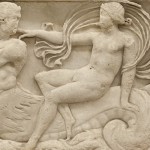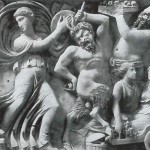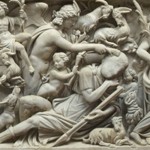History of Roman Sarcophagi
Lavish marble sarcophagi were a popular trend throughout the Roman empire beginning around the second century AD. A sarcophagus (plural sarcophagi) is type elaborate coffin used to house the bodies of the deceased. Before this point in Roman history, cremations were a much more common choice. The ashes of the deceased were placed in urns instead. These expensive reliefs represent the luxurious side of the Roman funerary tradition.[1] The sarcophagi would be visited by family and friends on particular holidays and days of remembrance. Often the living would partake in a feast near their loved one’s tomb. In Roman tradition, only the emperor could be buried inside city walls. Everyone else was buried along the roads leading to the city. To learn more about the specifics of Roman funeral traditions, click here.
Rome was home to the majority of marble workshops that crafted these sarcophagi. The two major shapes of Roman sarcophagi are the box and the lenos, or tub. The box shaped sarcophagi were the more common of the two. They were low and rectangular with a flat lid. Lenos sarcophagi were tub-shaped and resembled a trough for pressing grapes. Most sarcophagi were placed against a wall, therefore they were only decorated on the front and sides.
Mythological scenes were popular. This reflected the upper-class Roman taste for Greek culture and literature. Romans understood these reliefs to be a type of funerary poetry in pictures. There was no single message or reason for a myth to be chosen for a particular burial, instead there were many different readings and allegories that came from these sculptural pieces. The myths were not chosen by trained intellectuals, but instead citizens from different parts of society who could afford them. The myths represented on the sarcophagi were also chosen to decorate homes and other spaces, but they have different meanings in each context.[2]
Thematic Examples
Three major themes are most commonly found on marble sarcophagi. This is because they depict images of paradise. I have given each of these types of sarcophagi titles
 Beneath the Waves discusses sarcophagi showing peaceful and erotic scenes of mythological ocean-life. Though they did not follow specific mythological narratives, they borrowed fantastical sea creatures and various other miscellaneous ocean dwellers to populate their scenes.
Beneath the Waves discusses sarcophagi showing peaceful and erotic scenes of mythological ocean-life. Though they did not follow specific mythological narratives, they borrowed fantastical sea creatures and various other miscellaneous ocean dwellers to populate their scenes.
 Life of the Party is about sarcophagi that used imagery of worshipers of Bacchus. They showed moments from the god’s life, Bacchus’ followers, and invoked the idea of an eternal party by depicting drunkenness and merriment. This type of comforting scene differed from the sea sarcophagi in that the ocean seems a tranquil and sensual place while the Bacchic sarcophagi present a lively and more and celebratory one.
Life of the Party is about sarcophagi that used imagery of worshipers of Bacchus. They showed moments from the god’s life, Bacchus’ followers, and invoked the idea of an eternal party by depicting drunkenness and merriment. This type of comforting scene differed from the sea sarcophagi in that the ocean seems a tranquil and sensual place while the Bacchic sarcophagi present a lively and more and celebratory one.
 Sweet Dreams examines sarcophagi that followed a mythological narrative much more closely than the other two themes. The two major myths that were used to depict an eternal and restful slumber were Bacchus and Ariadne, and Selene and Endymion. Sleep was used as a metaphor for death but allows the deceased the chance to one day awaken. They are merely resting from the hardships of life and their being and soul is still present.
Sweet Dreams examines sarcophagi that followed a mythological narrative much more closely than the other two themes. The two major myths that were used to depict an eternal and restful slumber were Bacchus and Ariadne, and Selene and Endymion. Sleep was used as a metaphor for death but allows the deceased the chance to one day awaken. They are merely resting from the hardships of life and their being and soul is still present.
[1] Paul Zanker, “Reading images without texts on Roman sarcophagi,” Res 61/62 (2012), 169
[2] Heather Awan, “Roman Sarcophagi, In Beilbrunn Timeline of Art History,” The Metropolitan Museum of Art. Accessed December 16, 2015. http://www.metmuseum.org/toah/hd/rsar/hd_rsar.htm